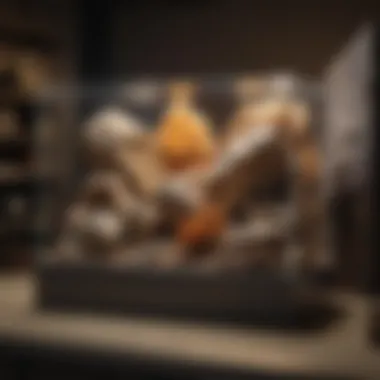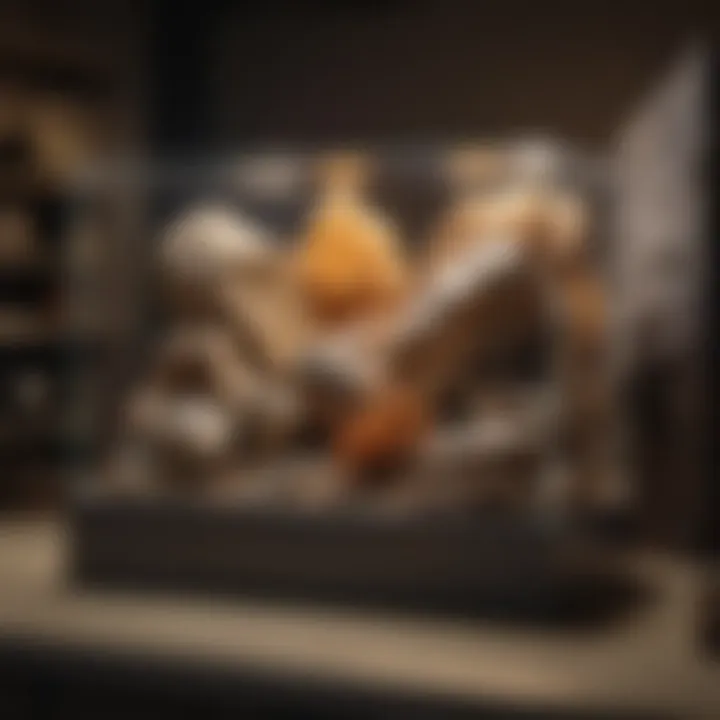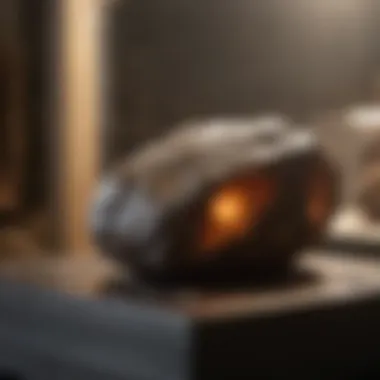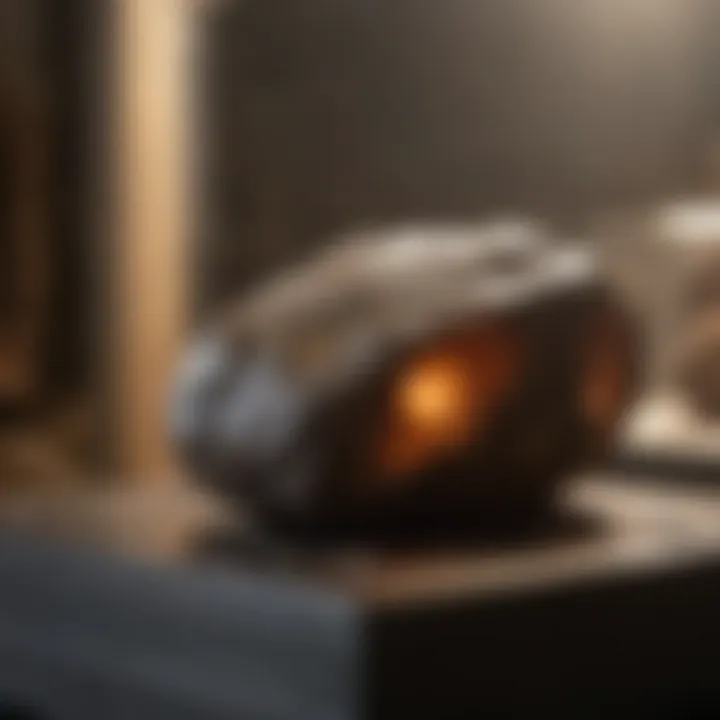The Role of Lighted Rock Display Cases in Geology


Intro
In the fascinating world of geology and mineralogy, the way we display rocks and fossils can dramatically influence how they are perceived. Lighted rock display cases are not merely functional; they serve as vital components in the art of showcasing these natural treasures. These cases enhance the beauty and texture of geological specimens, allowing collectors and educators to present their collections with precision and care.
There’s an undeniable magic that happens when light interacts with geological specimens. The glimmer of quartz crystals, the deep luster of precious stones, or the intriguing patterns of sedimentary layers become even more captivating under the right lighting. In this article, we will explore various design considerations for lighted display cases, the impact of light on viewer perception, the materials used in these cases, and best practices for maintenance. This comprehensive exploration aims to enrich your understanding and appreciation of both the art of display and the treasures of geology.
Featured Collectible of the Month
Overview
When discussing lighted rock display cases, it’s essential to highlight a captivating specimen that embodies the fusion of art and science: the stunning Amethyst geode. This geological wonder, a hollow rock formation lined with vibrant purple quartz crystals, can be the centerpiece of any collection. The way a well-lit display case showcases the luminescence of the Amethyst draws visitors in, igniting curiosity and admiration.
Historical Significance
Amethyst has a rich history, with its significance tracing back to ancient civilizations. The Greeks believed that Amethyst could prevent intoxication, attributing protective properties to this beautiful stone. In the Middle Ages, it was frequently used in religious artifacts and adorned crowns of royalty. Today, this gemstone is treasured not only for its beauty but also for its cultural heritage.
"Amethyst is more than just a stone; it’s a testament to human history, connecting generations through its unyielding allure and significance."
To create a display that honors the Amethyst's historical importance, consider incorporating design elements that reflect its ancient roots while utilizing modern lighting techniques that enhance its natural splendor.
Identification Techniques
Visual Characteristics
Identifying geological specimens like Amethyst requires an eye for detail. Here’s a quick guide to its primary visual features:
- Color: The rich purple hue is the standout trait, with variations from light lavender to deep violet.
- Clarity: Clear crystals showcase a glass-like finish, while more opaque specimens reveal a hazy interior.
- Form: Look for a distinct crystal structure. The hexagonal shape of quartz crystals is a telltale sign of Amethyst.
Resources for Identification
For both hobbyists and seasoned collectors, recognizing geological specimens is crucial. Here are some resources to aid in identifying Amethyst and other minerals:
- Books: "The Rock and Gem Book" by Clive Gifford offers excellent illustrations and details.
- Web Resources: Websites like Wikipedia provide a wealth of information on the geological and historical context of minerals.
- Community Forums: Participating in discussions on platforms like Reddit can provide insights from fellow enthusiasts, sharing personal experiences and identification tips.
Preface to Lighted Rock Display Cases
Lighted rock display cases stand at the intersection of art and science, creating an environment where geological specimens can truly shine. This section delves into the fundamental aspects of these display cases, underscoring their importance in preserving and showcasing the beauty of natural specimens. As collectors and enthusiasts navigate the world of geology, understanding the impact and considerations of display cases becomes crucial.
Purpose and Significance
The primary purpose of lighted rock display cases is twofold: preservation and presentation. When rocks and fossils are adequately illuminated, they don’t just become more visible; they tell a story. Light plays a significant role in revealing the intricate textures and colors of minerals that might go unnoticed under conventional lighting. Moreover, a well-designed display case safeguards these items from environmental factors like dust, humidity, and physical damage.
Collecting isn’t merely about possession; it’s about stewardship. Display cases provide collectors a way to honor the natural wonders they've gathered, elevating these pieces from mere objects to cherished artifacts of history. By employing proper lighting techniques, a collector can create a rich narrative experience that invites admiration and respect for the geological treasures housed within.
Appeal to Collectors and Hobbyists
For collectors and hobbyists alike, the allure of lighted rock display cases is undeniable. These cases allow them to transform their collections into stunning exhibits worthy of a museum. Enthusiasts appreciate how light accentuates unique features of their specimens, drawing attention to delicate formations and vibrant hues that tell tales of millions of years.
Moreover, display cases facilitate connections within the community. Collectors often share their setups through social media platforms such as reddit.com and facebook.com, seeking inspiration and giving tips on how to create their personal showcases. The flourishing dialogue about display techniques and case designs only deepens the appreciation for this fascinating hobby.
Lighted cases do more than hold specimens; they serve as conversation starters and educational tools. When thoughtfully arranged, they invite viewers into a world where geology intertwines with art, making the beauty of each rock accessible to everyone, irrespective of their expertise. Ultimately, the art and science behind lighted rock display cases play a crucial role in elevating the experience of collecting from a solitary act to a shared celebration of nature's artistry.
Design Considerations for Display Cases
When showcasing geological specimens, the design of the display case greatly influences viewer engagement and appreciation. The purpose behind a clever design is not only to protect the rocks and fossils but also to enhance their beauty and uniqueness. It's a balancing act that entails thoughtful choices about size, materials, and aesthetics. These elements all come together to create a captivating presentation, ensuring that each collection feels both personal and authoritative.
Size and Dimensions
First things first, the size and dimensions of a display case matter a lot. Consider the space where the display will be placed. A case that is too large can overshadow the specimens, while an undersized one might fail to make them the center of attention. Here’s what to keep in mind:
- Proportion: Make sure that the case is proportionate to the specimens. A tall crystal deserves a display that complements its height, while smaller, flatter fossils might need a wider base to show off their surface.
- Accessibility: Think about how viewers will interact with the display. If the case is too high or too low, it might just be a bothersome sight rather than an enthralling piece. Finding the sweet spot makes a world of difference.
- Room for Growth: Rock collections can expand. Opt for a case that allows for additional pieces, so your display can evolve alongside your collection. It's like planting a seed that can flourish over time.
Material Choices
The material used in crafting display cases is equally crucial. Choices here can lend a certain character to the display. Here are some common materials and their pros:
- Glass: Provides clarity. It allows light to illuminate the specimens while acting as a barrier against dust and damage. However, careful thought must go into the frame; a wooden frame can match a rustic collection, while metal might suit a contemporary one better.
- Acrylic: Lighter and often less expensive than glass, acrylic also offers clarity. But it can scratch more easily. Use it in environments where tough conditions dominate.
- Wood: If you want to bring warmth and a natural feel, wooden cases can encapsulate that essence. Different finishes can match the character of your pieces. However, wood needs proper treatment to resist moisture.


Choosing the right material affects not only the presentation but also the long-term durability of the display. A case should be built to last while allowing the specimens to shine through.
Aesthetic Elements
A least attractive display case is one that looks hastily assembled. The aesthetic aspects of a lighted rock display case shouldn't be an afterthought; they add depth to the viewer’s experience. Think about these elements:
- Lighting Effects: Integrated lighting can transform any seen specimen into a striking focal point. Specialty lights can accentuate the natural structure. Warm lights can create a cozy feel, while cool tones can invoke a sleek, modern ambiance.
- Color Schemes: When matching colors, consider how they represent the collection. Rich, deep colors might align well with darker minerals or fossils, while lighter shades can create a contrast that makes vivid colors pop.
- Displays of Depth: Creating layers within the display can add a sense of depth and movement. Use risers or platforms to create varying heights among specimens, encouraging the viewer's eye to wander and discover.
"A well-designed case doesn’t just hold specimens; it tells their story, inviting viewers on a journey through time."
Designing a display case isn't merely about housing specimens; it's about giving them a home that elevates their natural beauty. Consider these design elements as a way to bring life and character to your geological treasures.
Lighting Types and Effects
Lighting is far more than just a means to illuminate; it’s a crucial component that breathes life into rock display cases. Selecting the right lighting type can transform the experience of viewing geological specimens, enhancing their beauty, and showcasing their unique features. Therefore, understanding the various lighting options and their effects becomes imperative for collectors and hobbyists alike. This section will dissect the differences between LED and incandescent lighting, explore the influence of color temperature, and discuss the merits of adjustable lighting features.
LED vs. Incandescent Lighting
When it comes to display cases, the choice between LED and incandescent lighting can fundamentally alter the aesthetic outcome. LED lights are often celebrated for their energy efficiency and longevity. They consume significantly less power and can last tens of thousands of hours, making them a favorite for collectors who want to enjoy their displays without the constant hassle of changing bulbs.
Another undeniable aspect of LEDs is their low heat emission. This design consideration is particularly vital for precious fossils and minerals, as excessive heat can cause irreparable damage over time. These lights also come with a variety of color options, allowing collectors to choose a hue that enhances the specific qualities of their specimens.
On the other hand, incandescent bulbs provide a warm, natural glow that many find appealing. This type of light has traditionally been used in galleries for its ability to create an inviting atmosphere. However, they do come with drawbacks, such as higher energy use and shorter lifespans when compared to LEDs.
Ultimately, the decision hinges on personal preference, but it's wise to weigh the benefits of energy efficiency and longevity against the aesthetic warmth of incandescent lights.
Color Temperature and Its Influence
Color temperature is a fancy term that refers to the warmth or coolness of light, measured in Kelvins (K). For rock and fossil displays, the right temperature can do wonders in showcasing the specimens’ natural color, clarity, and inclusions.
Warm white light, generally around 3000K, can make a display feel cozy and appealing, perfect for showcasing earthy tones in rocks. This kind of light tends to emphasize the browns, reds, and yellows found in many geological specimens.
Cooler temperatures in the range of 5000K to 6500K provide a brighter, more clinical feel. They enhance blues and whites, making minerals appear more vibrant and striking. This cooler light is beneficial when showcasing clarity and brilliance in crystals.
An important note to remember is how color temperature can alter perception. A rock may look entirely different under various lighting conditions, which should be carefully considered during display planning.
"Choosing the right color temperature can not only enhance the visual appeal but can also evoke different emotional responses from viewers."
Adjustable Lighting Features
Adjustable lighting features can be a game-changer for rock display cases. These components allow collectors to customize the lighting based on their preferences, specimen types, and the atmosphere they wish to create.
Dimmable lights can add depth, giving viewers the ability to see the specimen in various light intensities. For instance, a dramatic display of a rare quartz can shine brilliant white under full brightness, while softer lighting can reveal subtle details otherwise missed.
Track lighting and spotlights are also great options for collectors who want to highlight specific features of their specimens. By directing light to precisely where it's needed, one can draw attention to unique patterns or colors.
Incorporating adjustable features ensures that the collector can adapt the display for different occasions—whether it's an intimate gathering or a formal exhibition—making it versatile and dynamic.
In summary, the types of lighting used in a rock display case interplay profoundly with how the specimens are perceived. From the choice between LED and incandescent bulbs to the nuances of color temperature and adjustable features, these elements contribute significantly to the overall presentation and preservation of geological treasures.
Impact of Lighting on Perception
The influence of lighting in rock display cases cannot be overstated. It serves not just as a functional aspect, but as a vital artistic element that shapes viewer experience in profound ways. Proper illumination can transform a standard cabinet into a captivating showcase that draws attention and invites contemplation. Understanding its impact offers rock and fossil collectors a pathway to elevate their collections, turning mere display into engaging narratives.
Enhancing Visual Appeal
Lighting plays a crucial role in elevating the visual quality of geological specimens. Well-placed lights can dramatically heighten the natural colors and unique textures of rocks. For instance, specimens with sparkling quartz or vibrant agate gain a new lease on life under the right light. A subtle warm glow can emphasize earthy tones, while cooler lighting can bring out the striking blues and greens in minerals.
Moreover, using layered lighting—such as combining ambient and accent lights—creates depth and dimension within the case. This layered effect ensures each piece stands out distinctly, avoiding a flat or monochromatic presentation.
To effectively enhance visual appeal, consider:
- Positioning Lights: Arrange the lights to hit rocks from various angles, ensuring shadows play softly rather than overpowering the colors.
- Using Color Filters: Using gels or filters can alter the light's color temperature, allowing more personalized presentations, like highlighting specific hues.
Highlighting Unique Features
Each geological specimen tells its own story, and lighting serves as the narrative thread. For instance, a striking fossil's intricate details may remain unnoticed under inadequate lighting. When illuminated correctly, fossilized structures—like the delicate lines in an ammonite—come to life, revealing secrets contained within for millions of years.
Consider focusing directional lights directly at such unique features. This spotlighting technique draws immediate attention, making the piece the center of the viewer’s gaze. It’s not just about visibility; it’s about creating a visual journey that prompts observers to lean in, investigate, and appreciate the distinct characteristics that set each specimen apart.


Creating Mood and Atmosphere
Lighting is a powerful tool for crafting an ambiance that speaks to the essence of the rocks and fossils on display. The warmth of low lighting can evoke feelings of nostalgia, while bright, cool light can impart a more clinical, scientific atmosphere. This emotional influence can guide how collectors—and their guests—interact with the display.
A well-designed exhibit can resonate with an audience’s curiosity or awe, depending on the lighting employed. Consider creating a tranquil mood with dimmer lights that encourage quiet reflection, juxtaposed with occasional brighter bursts to surprise and engage viewers. Furthermore, using colored lighting schemes—like a subtle blue to represent water—can create thematic displays that resonate with the natural origins of geological specimens.
"Lighting is not merely a utility; it is a channel through which art can communicate with audiences, turning ordinary displays into extraordinary experiences."
Ultimately, the perception driven by lighting in display cases is an intricate dance between art and science. By leveraging thoughtful lighting choices, collectors can forge connections not only with their specimens but also with those who visit and admire their collections.
Templates and Customization
The world of lighted rock display cases not only caters to aesthetic appeal but also prioritizes the functionality and protection of geological specimens. Within this sphere, the concept of templates and customization plays an integral role. Designers and collectors alike recognize the merit of templates, as they offer a structured starting point that aligns with various needs and preferences. However, customization further elevates these designs, tailoring them to individual collections in extraordinary ways.
When considering templates, it becomes evident that standardized designs provide numerous advantages. For one, they simplify the selection process for collectors who may feel overwhelmed by the vast options available. A standard design can resonate with the style of a collector's existing decor, establishing a sense of cohesion in their display area. Additionally, these templates often incorporate fundamental features that enhance preservation, such as UV-blocking glass or built-in lighting, ensuring that the specimens remain safe from common environmental threats, like dust and fading.
Customization, on the other hand, invites a deeper relationship between the collector and their display case. Collectors often desire something unique that reflects their personality and the essence of their collection. Tailoring cases can mean adjusting the size and shape to accommodate specific specimens or creating a case that fits seamlessly in a niche of the collector's home. The benefits of customization can be manifold:
- Reflects Personal Style: A customized case can embody the unique taste of the collector, stand out aesthetically, and encapsulate the story behind the collection.
- Accommodates Different Sizes: Geological specimens come in various sizes and formats. Customized cases can be crafted to fit unusually-shaped pieces without compromising protection.
- Adaptability: As collections grow, a customizable display case can often adjust, whether it's through modular design or additional features, offering a dynamic solution to keeping the showcase relevant as time passes.
"Customization transforms a simple display into a storytelling platform, allowing both the collector and the viewer a glimpse into the passionate journey behind each specimen."
Designers often contemplate the balance between template advantages and the allure of personal customization. The ideal approach usually involves starting with a robust template and then infusing elements of personal choice. The meticulous selection process for lighting, color schemes, and even material finishes can significantly impact the final presentation, ensuring the beautiful geological specimens remain the focal point while contributing to the display's character.
In essence, combining templates with thoughtful customization elevates the experience of showcasing rock and fossil collections. By leveraging the reliability of standard designs while incorporating bespoke details, collectors can achieve a harmonious blend of functionality and art. Through this approach, the magic of geological specimens can be highlighted effectively, captivating both collectors and visitors alike.
Maintenance and Care of Display Cases
Maintaining and caring for lighted rock display cases is essential for preserving both the aesthetic integrity and the condition of the geological specimens they house. It's not just about keeping the display looking good; regular upkeep significantly enhances the longevity of both the cases and the collectibles inside. A well-kept display case not only protects the stones, fossils, and minerals but also ensures that they are showcased under the best possible lighting conditions. In this way, proper maintenance directly correlates to higher appreciation of the collection as a whole.
Cleaning Protocols
Cleaning your display case is more than just a routine chore—it's an intricate part of the showcasing means. Dust and grime can accumulate quickly, creating a haze that can dull the vibrancy of the specimens. Here are some steps you can follow:
- Use Soft Cloths: Always utilize soft, lint-free cloths. Microfiber cloths are ideal as they trap dust without scratching the surfaces.
- Gentle Cleaning Solutions: When more than a dry cloth is needed, opt for mild soapy water or specialized display case cleaner. Avoid ammonia-based products that can discolor the materials over time.
- Dust Frequently: Establish a periodic cleaning schedule, depending on your environment. In dusty areas, you might find that weekly cleaning is essential, while in cleaner locations, bi-weekly or monthly could suffice.
"A clean display case is like a blank canvas; it allows every specimen to shine in its full glory."
When cleaning the inside, be especially cautious around the specimens. You may want to avoid touching them directly; instead, use long-handled tools or reach-in dusters. This reduces the risk of accidentally knocking them over or scratching their surfaces.
Avoiding Damage to Specimens
Preserving the integrity of the specimens inside the display case is crucial. These geological treasures often have delicate features that can be easily marred through mishandling. Here are several guiding principles to keep in mind:
- Minimize Physical Contact: Try to limit how often you take specimens in and out of the display case. Each handling increases the risk of accidental damage.
- Secure Lighting: Ensure that lighting fixtures are securely mounted, preventing them from falling into the cases. A dropped light can not only break but also cause harm to any specimens in its path.
- Monitor Temperature and Humidity: Certain minerals and fossils can be sensitive to extreme temperature fluctuations and humidity levels. Investing in a hygrometer and thermometer can help maintain ideal conditions to prevent any moisture damage.
Following these guidelines will contribute to a well-maintained display case, enhancing not only its longevity but also the joy and pride felt by collectors when showcasing their beloved natural artifacts. Keeping everything clean and protected elevates the entire experience for both the owner and any visitors to their collection.
Health and Safety Considerations
When it comes to displaying geological specimens, particularly in lighted rock display cases, health and safety cannot be overlooked. This section will highlight critical aspects that ensure the wellbeing of both the specimens and the individuals who admire them.
Electrical Safety in Display Cases
Electrical safety is paramount in any setup that integrates lighting, especially display cases that feature unique rocks and fossils. Improper wiring or installation can lead to short circuits or even electrical fires, which poses a great danger not only to the display itself but to nearby surroundings as well.
To minimize risks, it is important to:
- Use Certified Equipment: Always choose lighting fixtures and electrical components that are certified for safety standards, which help reduce the chances of malfunction.
- Proper Installation: Ensure that all wiring is done according to local electrical codes. If unsure, it’s best to consult a licensed electrician.
- Routine Checks: Periodically inspect the electrical setup of your display case for signs of wear or damage. Look for frayed wires or loose connections. Performing regular maintenance can prevent potential hazards.
"A well-lit display is only as safe as the wiring behind it."
Material Safety and Toxicity
Material safety and toxicity are often overlooked facets of creating display cases, but they play a vital role in preserving both the environment and the specimens. Some materials used in display cases, particularly certain plastics and adhesives, may emit volatile organic compounds (VOCs) or other harmful substances. This not only jeopardizes the health of collectors but can also affect the integrity of delicate specimens.
Consider the following when selecting materials:


- Choose Low-VOC Options: Opt for display case materials that are low in VOCs to minimize toxic emissions, providing a healthier environment for both people and specimens.
- Avoid Harmful Materials: Some paints, finishes, and glues may contain harmful chemicals. Always check product labels and, when possible, choose non-toxic alternatives.
- Consider Natural Materials: Wood and glass are often safer choices compared to synthetic alternatives. They tend to have less chemical off-gassing and are generally more stable for long-term display.
By addressing these health and safety considerations, collectors and hobbyists can rest assured that their displays not only shine brilliantly but also do so in a safe and responsible manner.
Showcasing Natural Wonders
When it comes to displaying geological specimens, the presentation can make all the difference. Showcasing natural wonders not only highlights the inherent beauty of rocks and fossils but also serves an educational purpose. These cases provide a platform through which collectors and admirers can engage with the marvels of the natural world. The right display setup can transform ordinary shells, minerals, or even larger geological formations into captivating pieces of art that catch the eye and inspire awe.
A well-thought-out display case achieves several goals. First, it protects precious items from environmental hazards like dust, UV rays, and physical damage, thus preserving their integrity for future generations. Similarly, display cases serve as a focal point, encouraging curiosity and discussion. When thoughtfully curated, these displays can tell a story about Earth's history, the processes that formed these specimens, and their significance.
Curating Geological Collections
The art of curating geological collections is about more than just arranging items aesthetically. It involves understanding the narrative each specimen can convey and organizing them to emphasize their unique qualities. Collectors can sometimes get lost in the sheer number of rocks they possess, but effective curation breathes new life into their collection.
Key considerations for curating include:
- Thematic groupings: Organize displays based on common characteristics like mineral types, colors, or geographic origins. This strategy makes it easier for viewers to appreciate the diversity within a collection.
- Labels and descriptions: Providing information about each piece enhances the educational aspect of the display. A well-placed label can spark questions and pique interest.
- Lighting and arrangement: How light interacts with specimens can greatly enhance their appearance. A well-lit display case allows colors and textures to shine, bringing out details that might go unnoticed otherwise.
The Role of Fossils in Display Cases
Fossils are a particularly intriguing subset of geological specimens. They represent a window into the past, offering unique insights into life on Earth millions of years ago. The role of fossils in display cases is not solely aesthetic; these remnants of history serve to educate and evoke a sense of wonder about our planet's evolution.
When selecting fossils for display, collectors should consider:
- Diversity of types: Featuring a variety of fossil types—such as imprints, casts, and true fossils—helps tell a broader narrative about different life forms and habitats from the past.
- Quality and preservation: Well-preserved fossils attract attention. The better the condition, the fewer distractions there are from appreciating the specimen itself.
- Contextual displays: Consider placing fossils in a thematic context, like a replica of their original environment. This not only enhances visual appeal but also adds educational value.
Fossils often take center stage in any geological collection. Their ability to spark conversations about ancient life makes them indispensable to display cases.
Integrating fossils into lighted rock display cases enriches the overall experience for viewers, encouraging them to delve deeper into the wonders of geology. When displayed thoughtfully, fossils help bridge the gap between past and present, allowing us to connect with a time long gone.
Inspiration from Exhibits
In the realm of lighted rock display cases, looking to the grandiosity and meticulousness of museums can offer fertile ground for ideas. Museums have long been the bastions of cultural and scientific treasures, and their strategies for presentation can be gold for collectors and hobbyists. Understanding the essence of these exhibits lays the groundwork for creating displays that resonate not only with aesthetics but also with educational value.
Lessons from Museums
Museums serve as a canvas, painting geological stories through their exhibits. One powerful lesson derived from these institutions is the use of context in displaying items. For instance, a simple rock crystal might not catch the eye on its own. But, when placed within a recreative environment representing its geological origins, it tells a story beyond its physical form. Here are several key takeaways from museums:
- Contextual Framing: Surrounding specimens with educational displays, such as diagrams or pictures of the environments where these rocks were formed, enhances viewer engagement. It cultivates a narrative that transforms mere observation into learning.
- Lighting Techniques: Museums employ various lighting effects to enrich the experience. Consider the spotlighting strategies used in most galleries, which accentuate textures and colors while minimizing glare. Mimicking these approaches can elevate a private collection into a gallery-like showcase.
- Rotation of Exhibits: Many museums rotate their exhibits, allowing visitors to experience new displays frequently. For collectors, adopting a similar approach can ignite renewed interest and provide a dynamic aspect to their collections that keeps both the collector and visitors engaged.
By internalizing these principles, personal displays can be imbued with a sense of purpose akin to that of a museum exhibit. This fosters appreciation and sparks curiosity among viewers—whether they are family members, friends, or fellow enthusiasts.
Innovative Designs Worldwide
Innovative designs in lighted rock display cases take inspiration from both traditional and contemporary museums around the globe, pushing the boundaries of what a display can achieve. Here are some notable ideas:
- Integration of Technology: Some exhibits incorporate augmented reality, allowing observers to interact with the collection digitally. A viewer can point their phone at a specimen and access layers of information or view a three-dimensional representation of geological processes.
- Sustainable Materials: There’s a rising trend toward using reclaimed wood and resins to create display cases that are both visually appealing and environmentally friendly. This not only aligns with the modern push for sustainability but also adds an organic touch appropriate for natural specimens.
- Minimalist Approaches: Many modern displays embrace minimalism, focusing on the specimen without overwhelming it with decorations. Clear acrylic or glass cases allow light to penetrate while keeping the viewer's eye trained on the rocks themselves. This might seem simple, yet it can accentuate the beauty of the specimens dramatically.
In summary, collectors and enthusiasts can draw inspiration from the sophisticated strategies employed in museum exhibits. Whether it's through contextualization, lighting, technological advancement, or design choices, the goal is to craft a narrative around each specimen that thrills and informs. Such thoughtful display not only celebrates the beauty of the geological world but enriches the journey of understanding that comes with it.
Finale: The Future of Display Cases
As we look ahead, the evolution of lighted rock display cases reveals a blend of art and science that goes beyond mere aesthetics. Understanding the future of display cases means recognizing how these pieces of furniture serve not only as a showcase but also as a vital tool for education and preservation. The innovative integration of technology, changing consumer preferences, and environmental consciousness shapes the landscape of display cases, ensuring they are relevant for years to come.
Emerging Trends
Recent years have seen several trends surface in the world of lighted display cases. One notable pattern is the use of smart technology. From automated lighting systems that adjust based on ambient light to temperature controls that help in the preservation of delicate specimens, these advancements push the boundaries of traditional display cases.
Another interesting trend is the increased emphasis on sustainable materials. Collectors are becoming more environmentally conscious, prompting manufacturers to create display cases from recycled or sustainably sourced materials. This choice reads as both an ethical commitment and a stylish statement.
Moreover, collectors are gravitating towards customization. Tailored solutions that reflect personal taste and unique collections not only enhance visual appeal but also foster a deeper connection between the collector and the displayed items.
- Smart technology enhancements
- Sustainable material options
- Customization and individualization
The Continued Importance of Display
Despite the introduction of new technologies, the fundamental importance of display cases remains unchanged. The display is not just about showing off items; it encapsulates the story behind each rock and fossil, maintaining their history and significance. Collecting is a journey, and lighted display cases serve as stopovers, helping narrate that journey visually.
A well-crafted display case can make even the most common specimen take center stage, enticing viewers and sparking curiosity. The marriage between light and display not only highlights unique features but also transforms the way observers experience geological art.
"In the right light, even the smallest rock can tell a grand story."
Additionally, display cases present an opportunity for education. They inform visitors about geological processes, the significance of preservation, and the beauty of nature. As educators embrace these cases in classrooms and museums, they contribute to broader knowledge dissemination.
In summary, while trends will continue to evolve, the need for well-designed, thoughtfully illuminated display cases that enhance the collector's experience remains perpetually relevant. For rock and fossil enthusiasts, investing in these displays ensures that their treasures are not only protected but showcased in a manner that respects their natural beauty and rich history.



